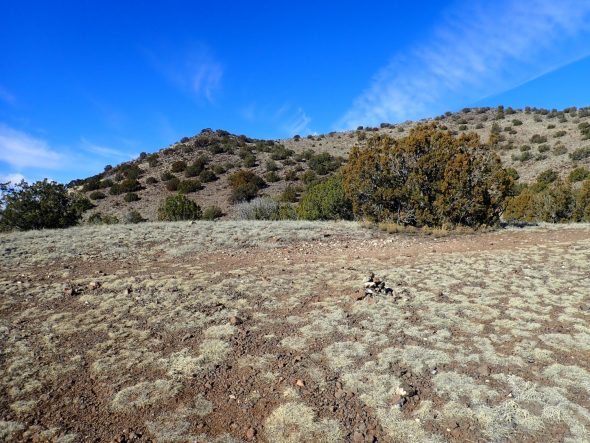
Odds and ends
Some geology, a little microscopy, and some personal (possibly TMI) stuff. You were warned.
We’re having not too dry a winter, which is wonderful as far as it goes, but it continues to hinder geologic adventuring. I did find time over the Washington’s Birthday weekend to visit Cerro Seguro, not once, but twice.
Cerro Seguro is the highest ground near La Cienega and its interesting geology. I visited some years back, but I was up for a new visit, now that I understand the local geology better. It’s a plug of Cieneguilla Basanite over Ortiz monzonite and affords a nice view of the surrounding area.
Let’s unpack that. Basanite is as uncommon kind of volcanic rock that forms from very low-silica magma that erupts at the surface. This magma has less than 45% silica by weight, but has a relatively high abundance of alkali metals (sodium and potassium). Normally alkali combines with silica and aluminum to form the mineral, feldspar, which is probably the most common mineral type found in the Earth’s crust. When silica is low and alkali content is high, there is not enough silica to combine with all the alkali as feldspar, and you get unusual minerals called feldspathoids. Sodium feldspar (albite) has the composition NaAlSi
Ordinary basalt, the most common low-silica volcanic rock, is a mixture of plagioclase feldspar (containing sodium and calcium) and pyroxenes. Basanite has some plagioclase, but much of this is replaced with nepheline, and olivine is present. There is also typically magnetite (magnetic iron oxide) and pyroxene. Basanite eruptions occur where small quantities of magma are tapped from relatively deep in the mantle as a result of a low degree of partial melting. There is only enough heat to melt a small fraction of the rock, barely enough to separate from the rock and rise to the surface, and it’s the fraction rich in alkali that melts first.
The Cieneguilla Basanite is named for the nearby village of Cieneguilla, as is customary geologic practice, and is found at the surface only in the La Cienega area. However, thin flows seem to be present in deep wellholes drilled to the east, close to Santa Fe. It is about 25 million years in age, based on radiometric dating, and represents an early stage in the opening of the Rio Grande Rift.
At Cerro Seguro, a dark plug of basanite sits atop older outcrops of Ortiz Monzonite. Monzonite is a rock significantly richer in silica that mostly cooled underground. It is mostly a mix of akali and plagioclase feldspar, with some quartz. The Ortiz Monzonite was emplaced around 34 million years ago as part of the Ortiz Porphry Belt, which stretches from the La Cienega area to South Mountain east of the Sandia Mountains. This is an historically important mining district, since the solidifying monzonite magma “sweated” fluids rich in copper, lead, gold, and other valuable substances. Turquoise, formed from copper-rich fluids, has been mined here since prehistoric times, and gold was mined in the district as late as 1986.
So the Friday before Washington’s Birthday, I had an appointment in Santa Fe to have my head examined. Pardon the possible too much TMI; I’ve mentioned in previous posts that I’ve been having mild but persistent headaches since before Christmas. Since these haven’t resolved, I got sent to have an MRI of my head. My great fear was that I would have to report back that my brain scan found nothing. 😉 The scan was early in the morning, was fairly straightforward (lie on a gurney and be scanned, get some gadolinium contrast injected, be scanned again) and was done by 8:00. I then went over to Matheson Gas to get my CO2 cylinders filled for my aquarium. Turns out it doesn’t work that way; you swap cylinders. I should have guessed. But my cylinders were acceptable for swap, so I didn’t need to put down the initial cylinder deposit. On the other hand, the place was having computer problems and couldn’t process the swap. I decided to go hiking for a couple of hours while they got their IT worked out.
The trail head.
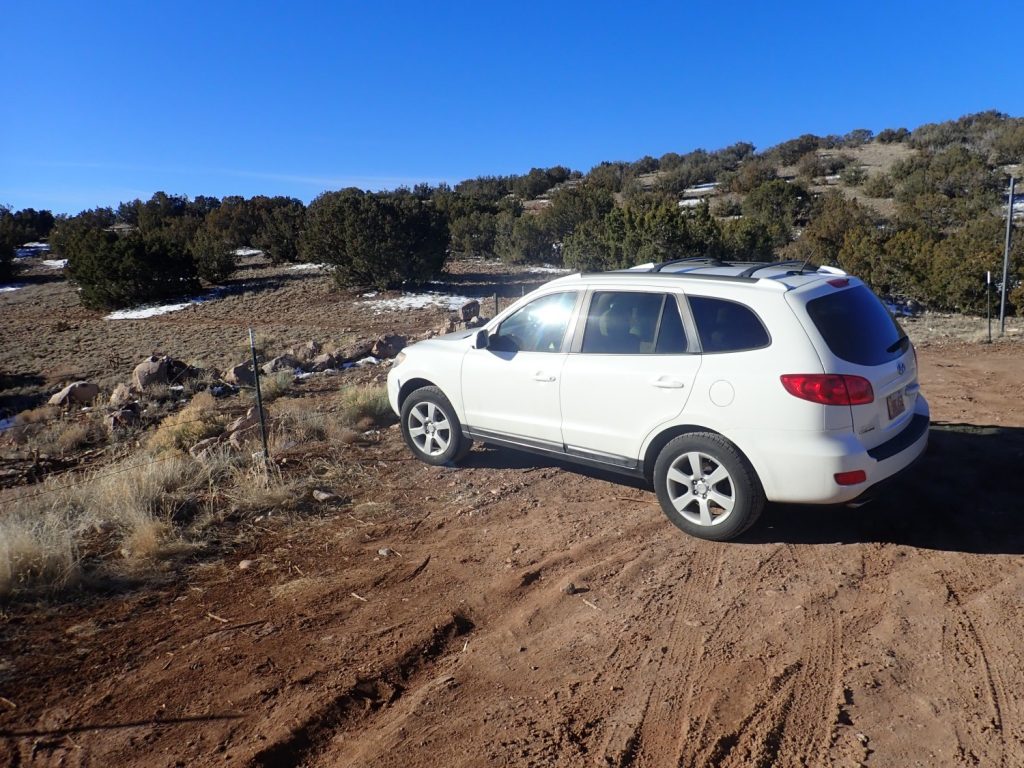
You can see that there is still some snow on the ground, but it’s not much, and this is a fairly rocky trail. I didn’t have any real difficulty with mud.
I didn’t head straight for Cerro Seguro. Instead, I wanted to check out some geology along the Santa Fe River, if I could get to it. The road continues past the trailhead towards the tiny settlementy of Canon.
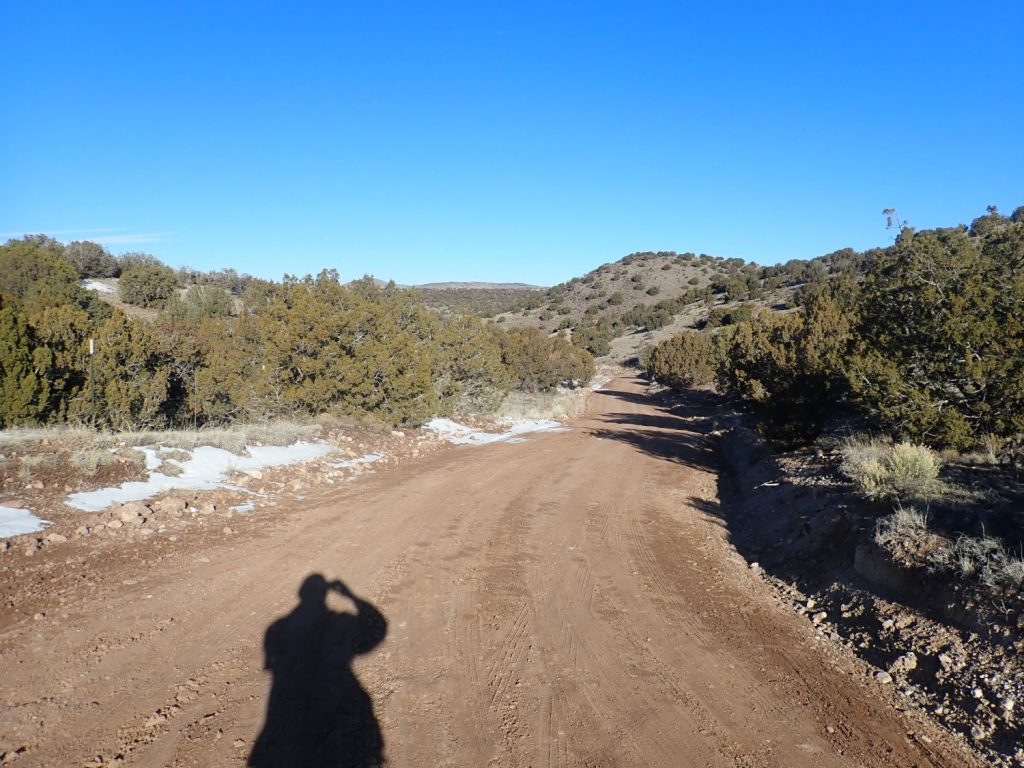
Canon is private land, but the surrounding area is state or BLM land, and I planned to bushwack through the hills north of Canon to get to the river and the outcrop I was interested in. Here the Cieneguilla Basanite rests on Espinaso Formation, a slightly younger formation than the Ortiz Monzonite but arising from the same volcanic centers. Espinaso Formation is mostly debris that actually made it to the surface.
New Mexico has a long religious tradition.
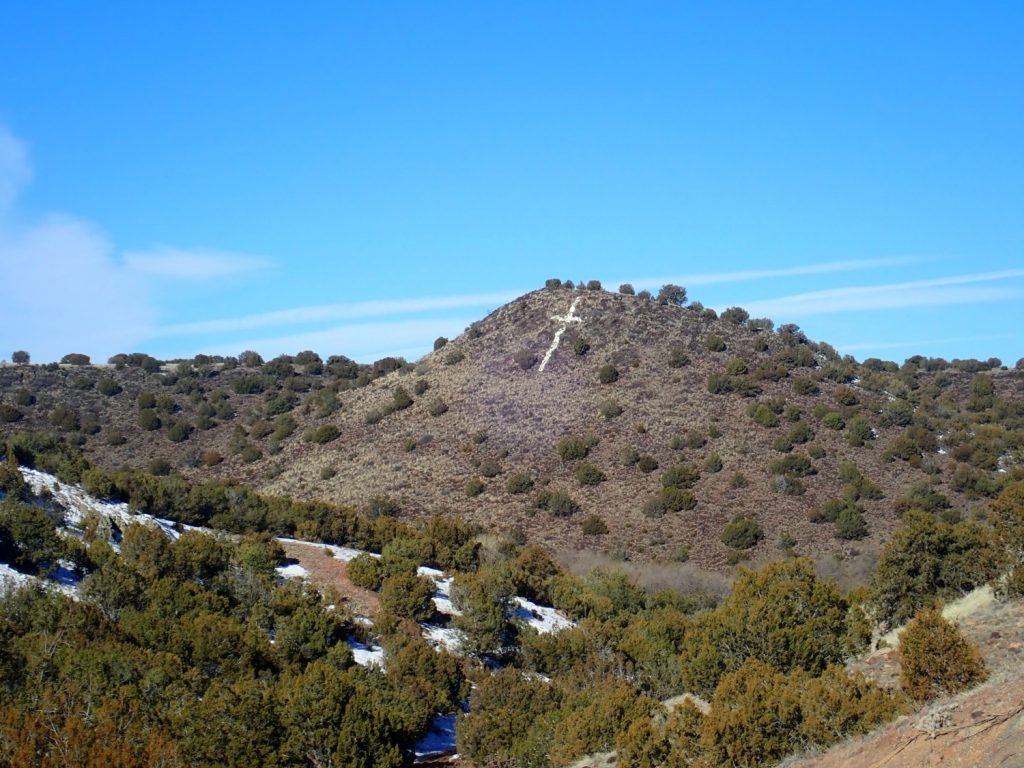
This is on a hill west of Canon.
Alas, I encountered a barbed wire fence across my path and I didn’t know what land jurisdictions it separated. I am loath to cross a wire fence onto private land, so here I turned back.
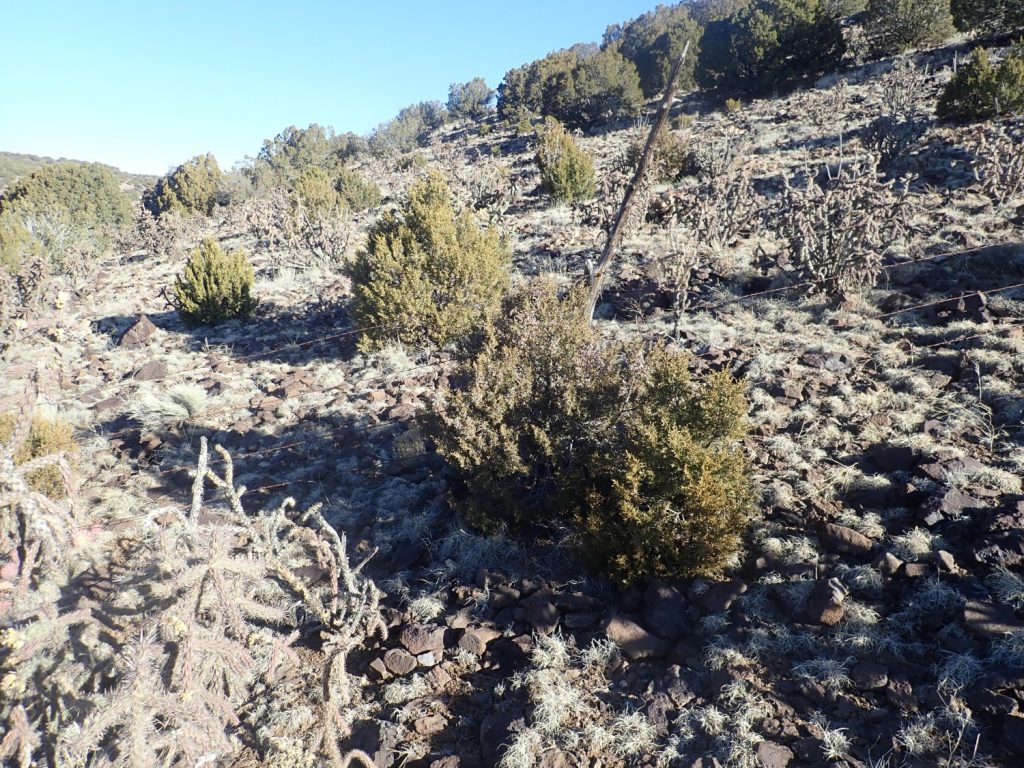
Turns out I could probably have crossed. Looking at the jurisdiction map after I got home, I found the entire area colored as BLM land, so this is likely a fence separating BLM units. It’s intended to restrict the movement of cows, not people. But I didn’t know that at the time. Moo.
Looking west across the river.
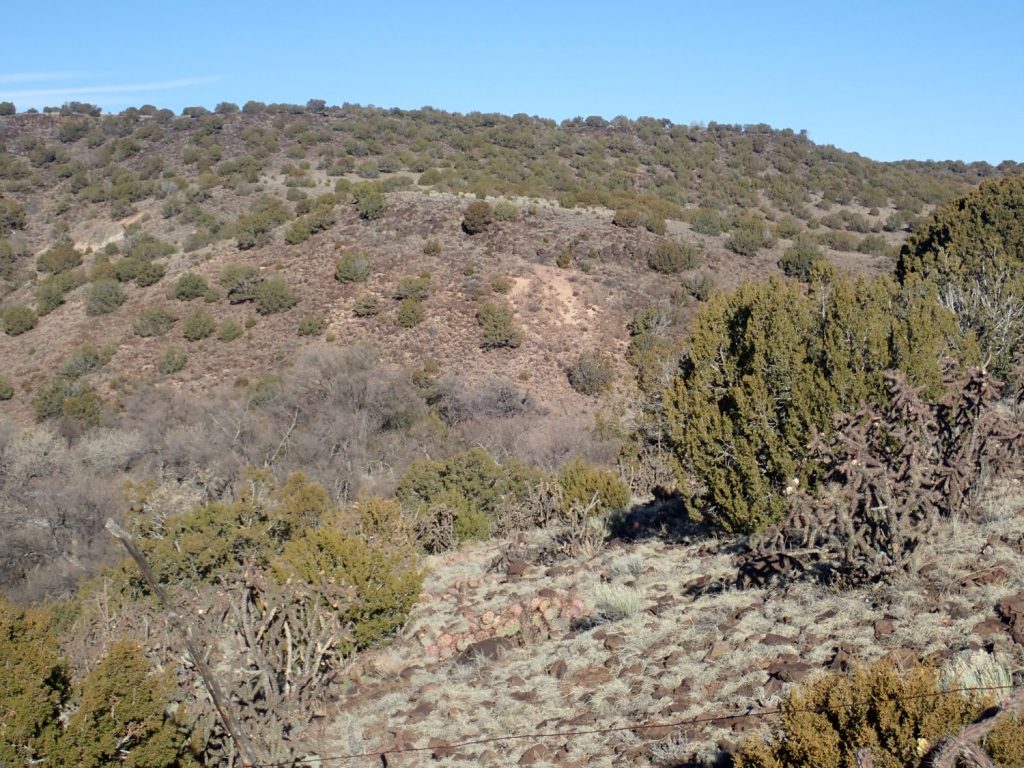
The outcrop I wanted to get to is actually on the east side of the river, facing away from me. I found it on Google Earth and it appears to show the stratigraphy of the Cienega Basanite and underlying Espinaso Formation well. Well, I’ll probably get another chance.
I do at least get a nice view of the Santa Fe River canyon to the southwest.
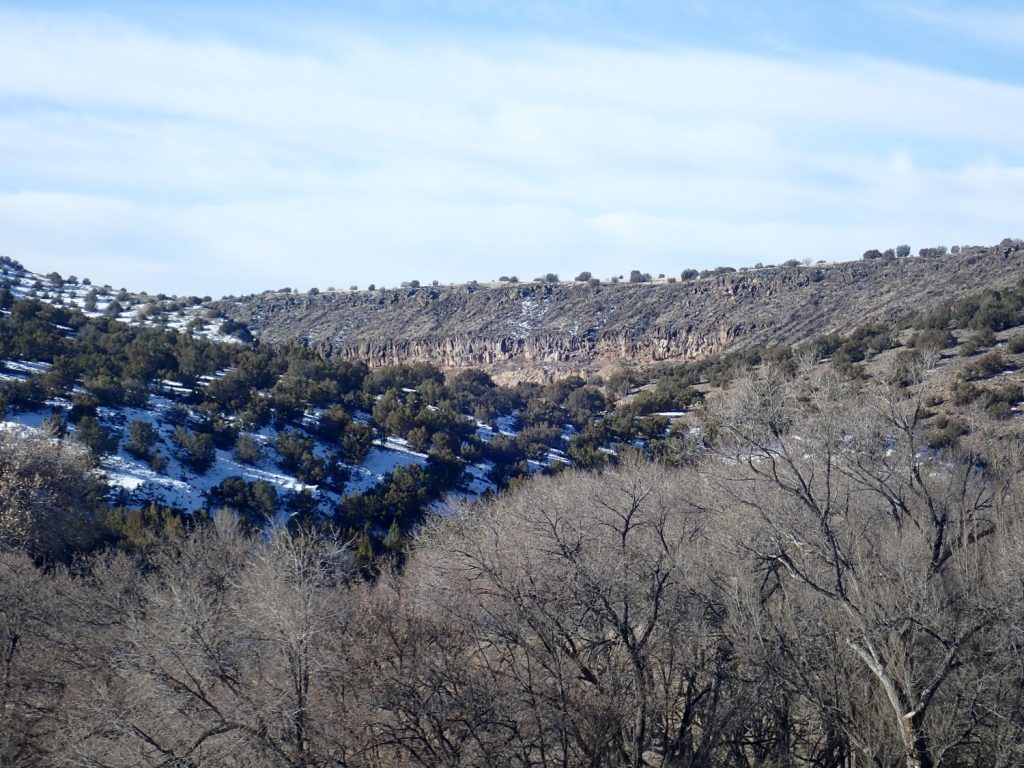
This shows dark basalt of the relatively young Cerros del Rio (around 3 million years old) resting on older light-colored Ortiz Monzonite.
I take time to follow the contact between the Cieneguilla Basalt and the underlying Espinaso Formation. I discovered on an earlier visit that the topmost bed of the Espinaso Formation seems to be a thin and relatively level latite flow.
Here:
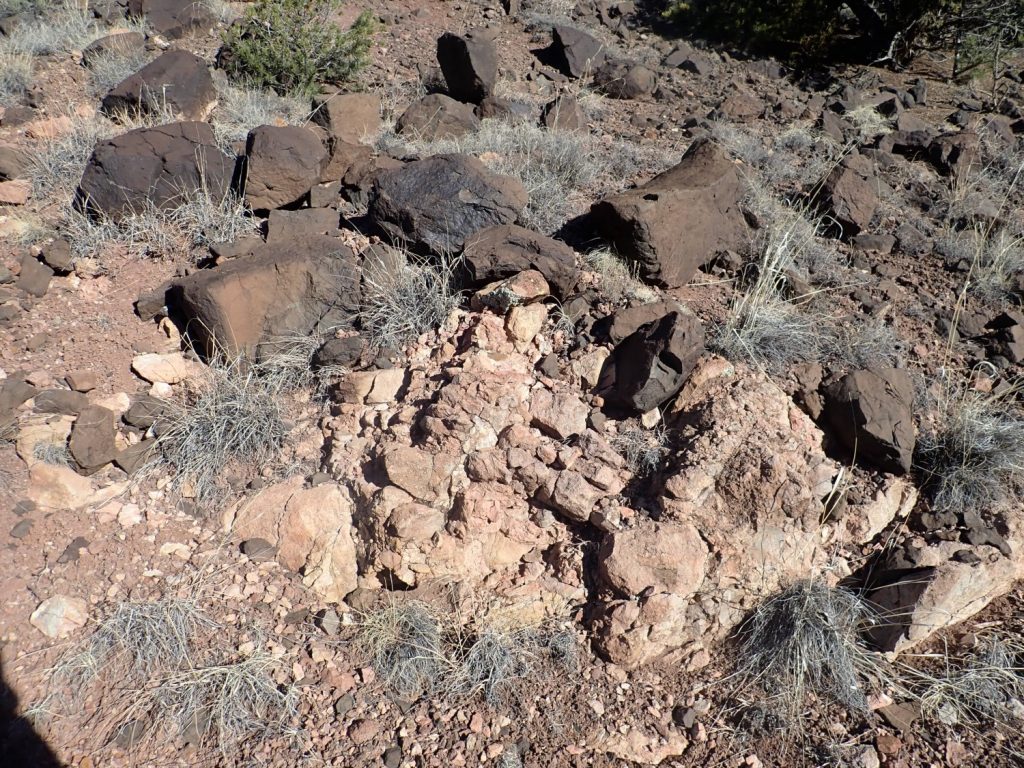
You can see the light pink latite (almost a tuff) under dark boulders of basanite. Also here:
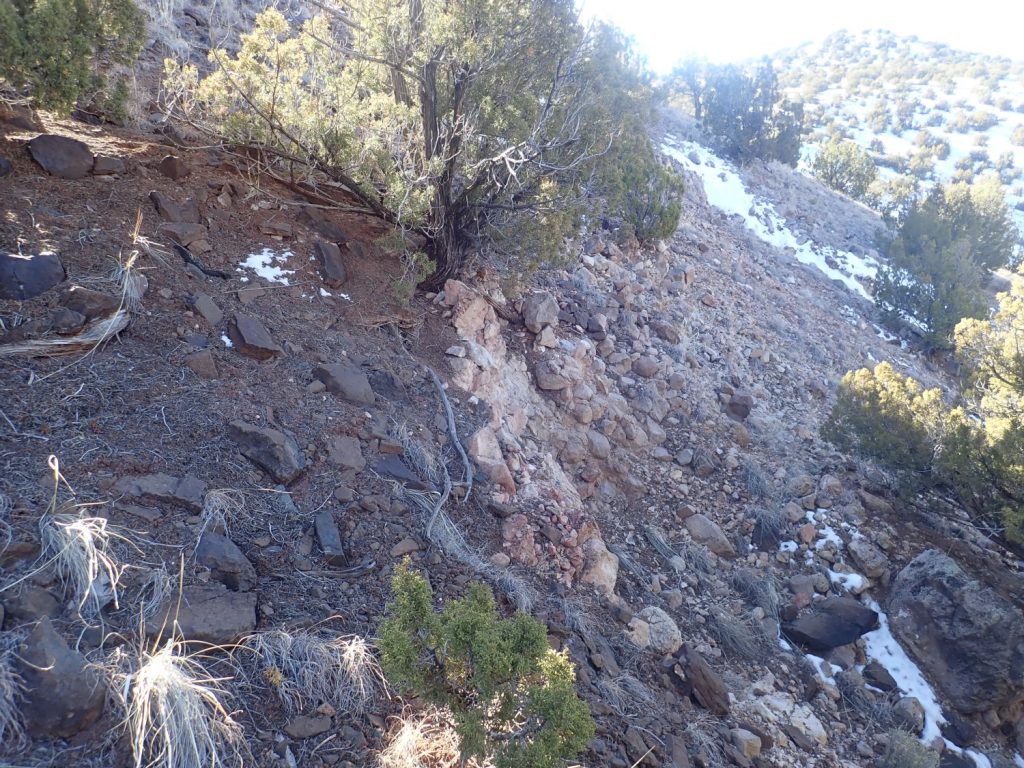
and here:
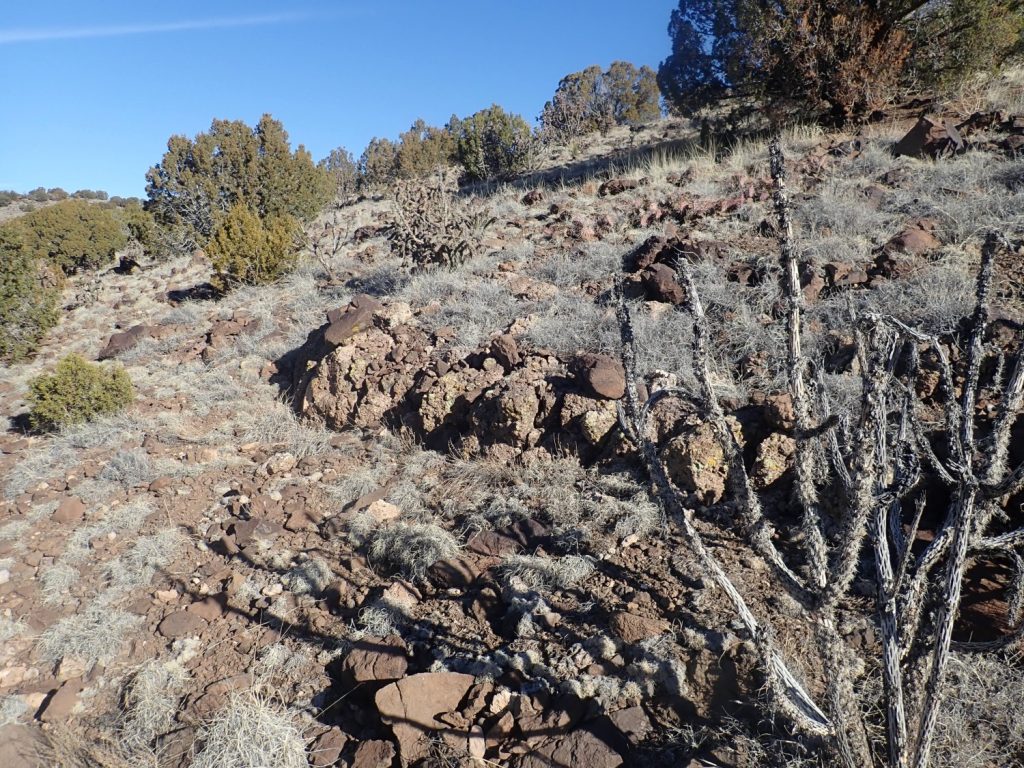
and here:
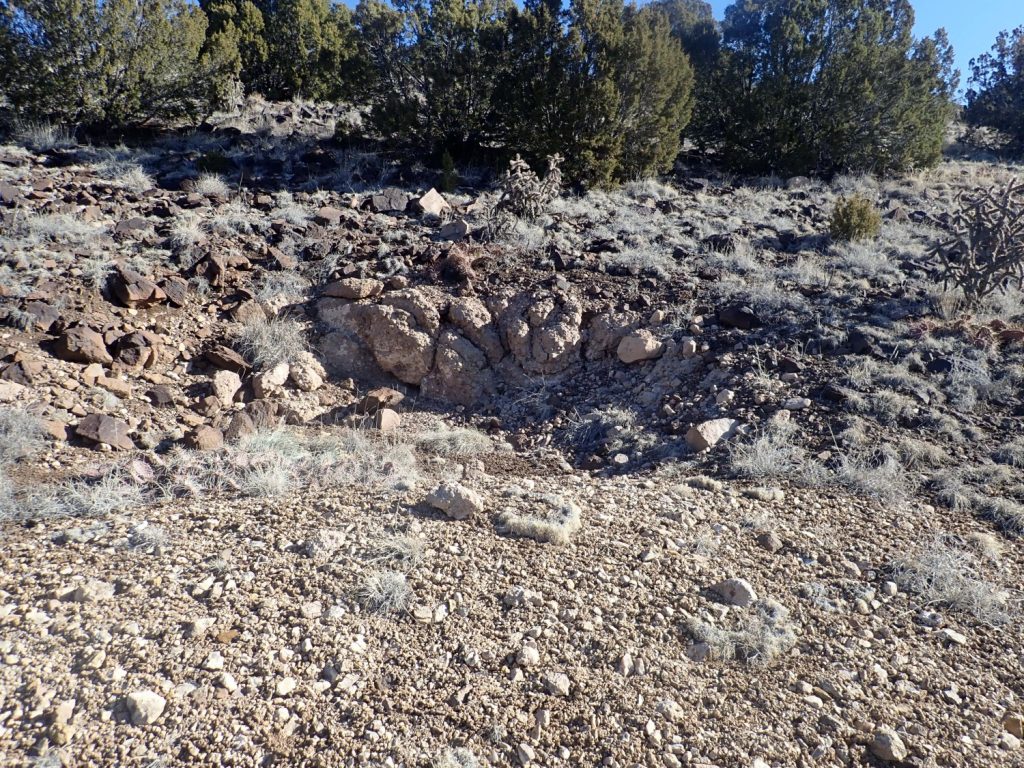
This last location appears to be a prospect pit. The prospector was probably attracted by bits of chert:
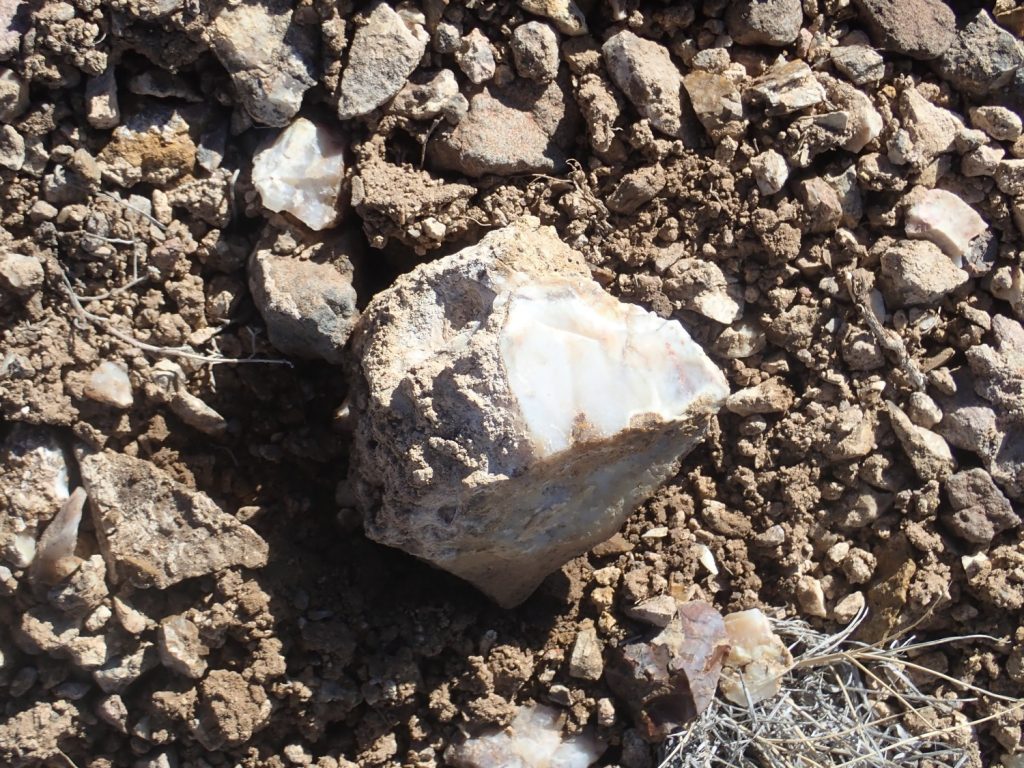
Chert is very fine-grained silica, and in an area like this one, it indicates hydrothermal activity. I saw evidence of this on my earlier visit. The activity was likely associated with the eruption of the Cieneguilla Basanite, based on finding a dike of basanite penetrating Espinaso Formation debris flow beds that had been hydrothermally altered.
Back at the trail head. It’s not as muddy as it looks.
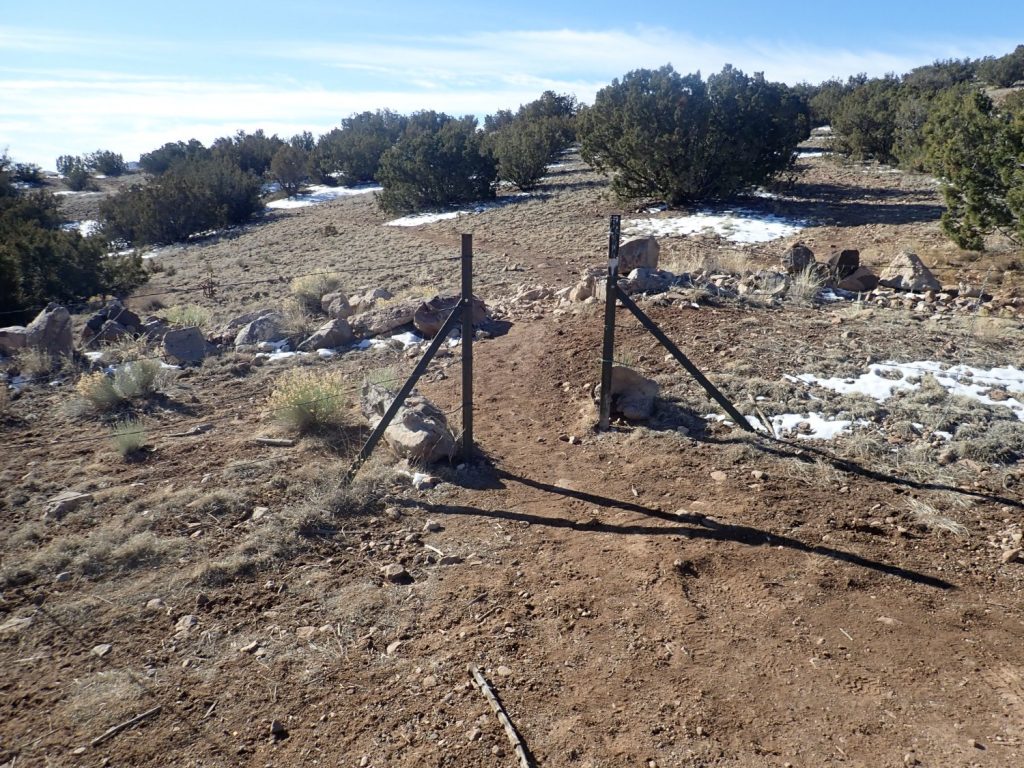
Last time, I was unfamiliar with the trail, which grows indistinct in spots, and ended up bushwacking. This time I was able to follow the trail all the way through. (It helped that there were footprints from an earlier visitor.)
View of Cerro Seguro, with dark basanite top and light outcrops of monzonite at its base.
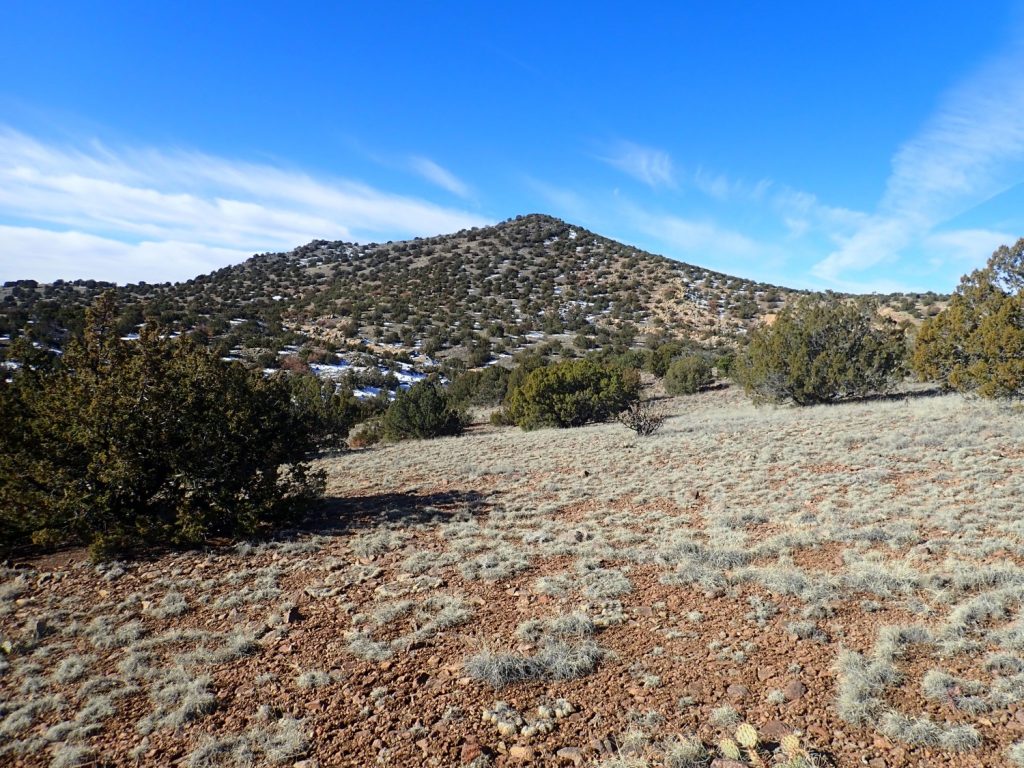
Helpful rock cairn at a trail junction.
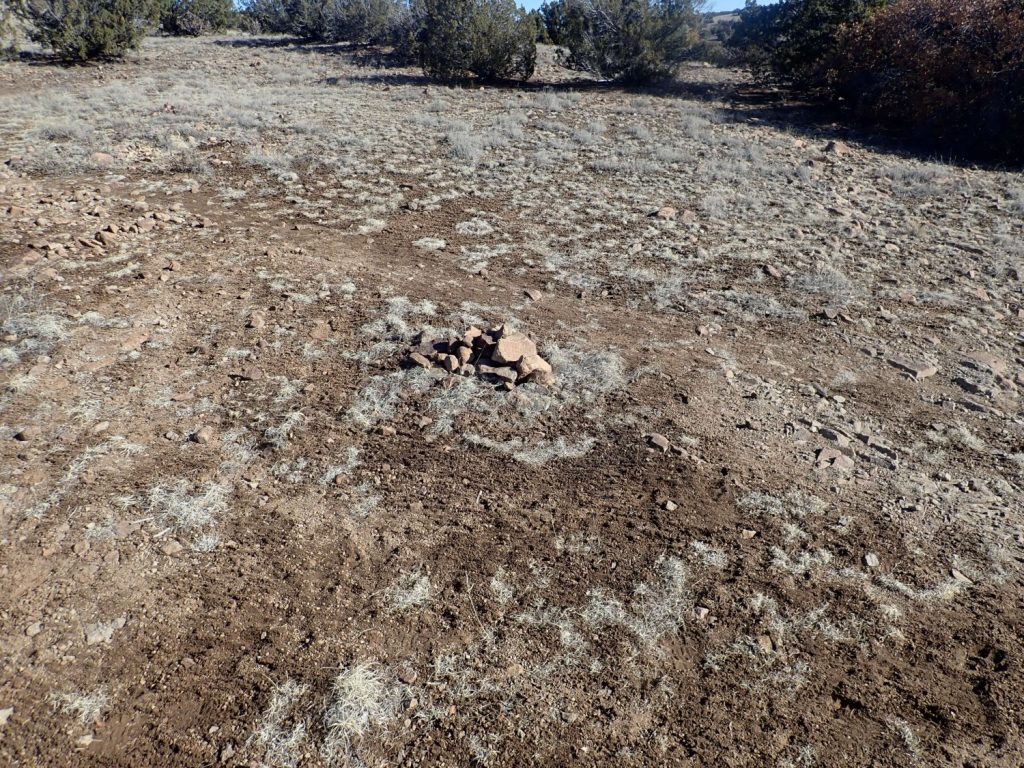
The trail is quite rocky, with exposed layers of monzonite.
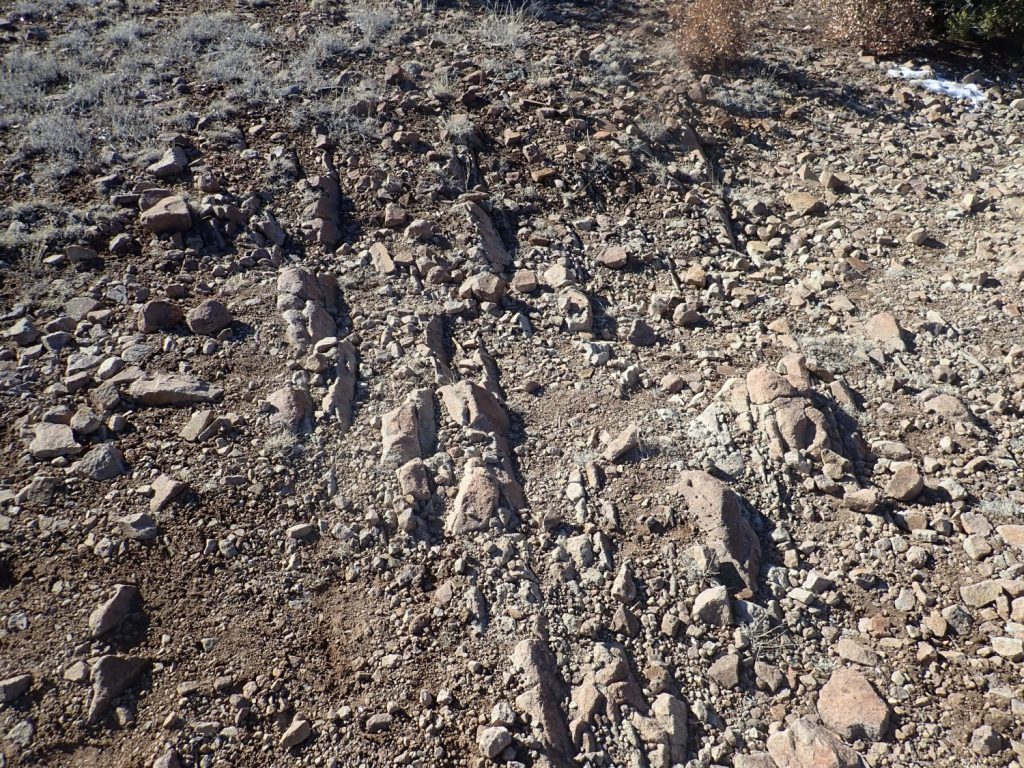
The road up the hill.

(Click to enlarge)
One of the characteristics of the Cieneguilla Basanite is that it contains a fair number of xenoliths. These are bits of rock from underground that are entrained in the rising magma and do not melt before the magma itself cools and hardens. The xenoliths in the Cieneguilla Basanite include monzonite xenoliths.
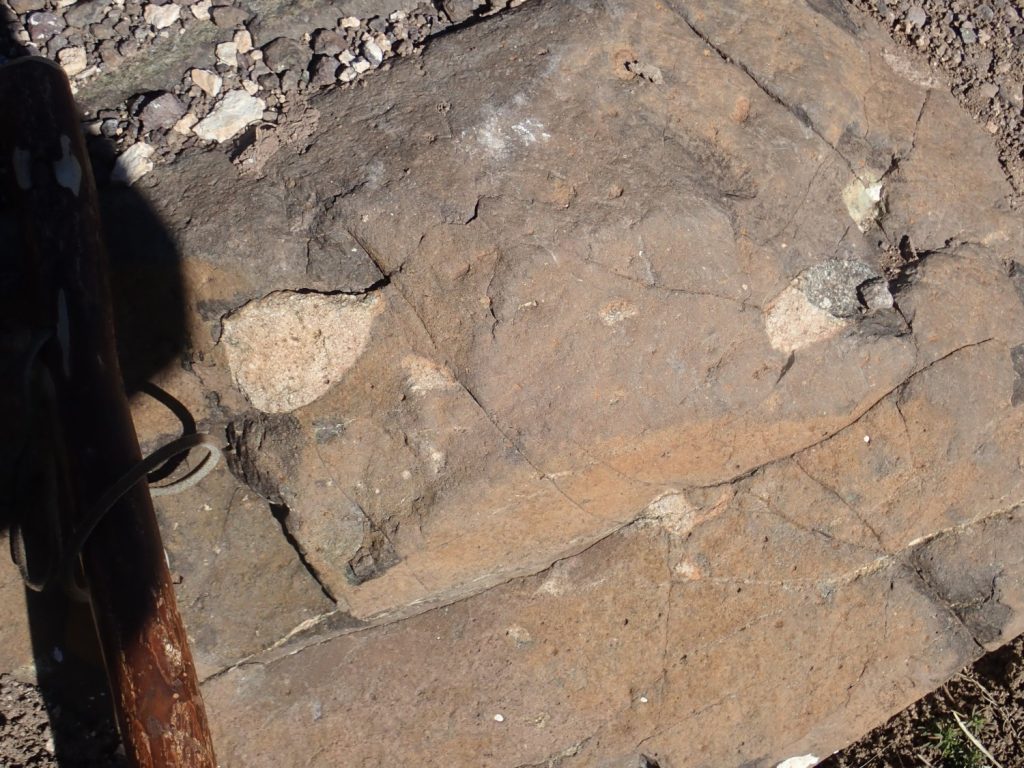
These are shallow xenoliths, entrained just below ground level. But there are also mantle xenoliths in the Cieneguilla Basanite, representing bits of the upper mantle that made it all the way to the surface. Because they are composed mostly of unstable olivine, they tend to rapidly decompose to red rusty patches on exposed surfaces. I’d love to get one that has not weathered, but since this would mean breaking open a lot of basanite at random in hopes of getting lucky, I’m not holding my breath.
I took this photo near where I estimated the highest monzonite rock was exposed, marking the contact between monzonite and basanite.
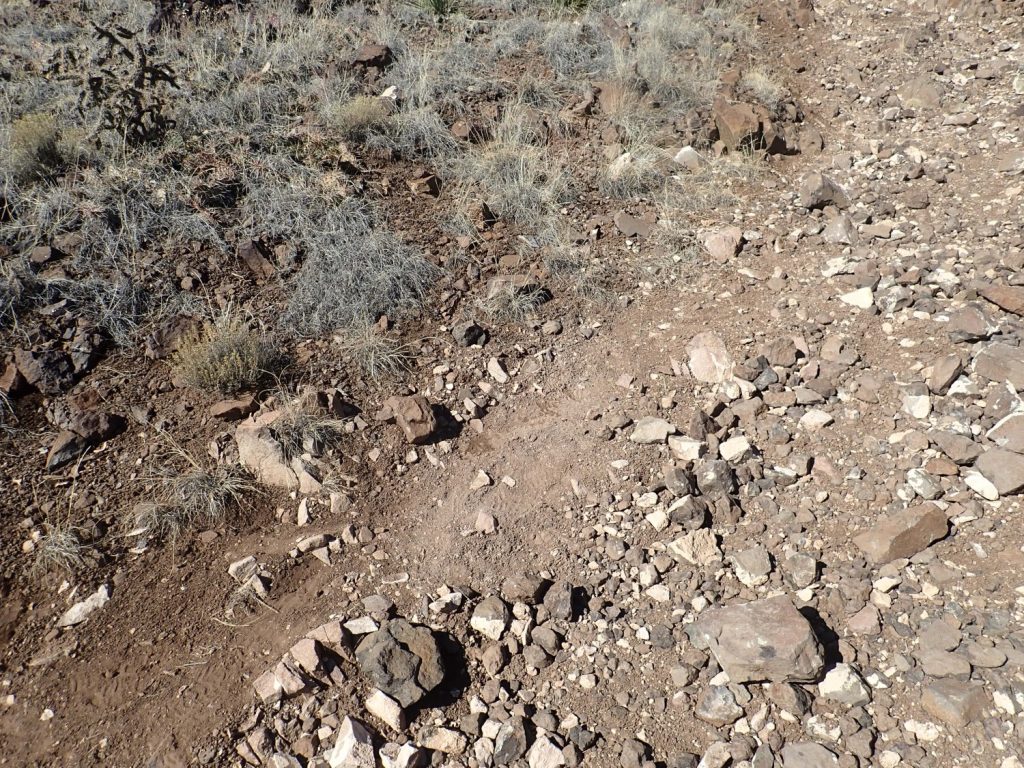
After I get home, I check the GPS coordinates and, yeah, it’s about where the geologic map puts it. I know, but it seems worth practicing this skill.
The final stretch. This is where the trail mostly ends.
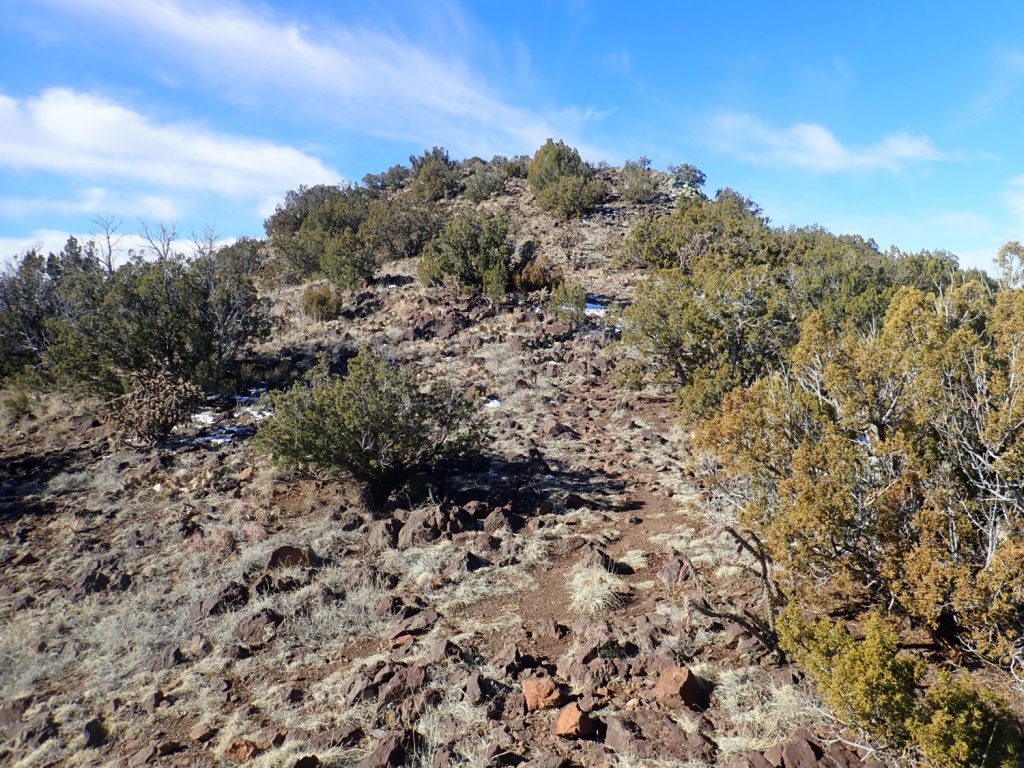
At the top, looking west.

(Click to enlarge)
At left in the middle distance are the Cerillos Hills, part of the Ortiz Porphry Belt. There is a nice state park here with trails to the historical mines. Then comes Sandia Crest on the skyline, and the canyon of the Santa Fe River. This cuts through the Cerros del Rio basalt plateau. The symmetrical cone right of center is Tetilla Peak. There are some impressive columns of monzonite exposed in the canyon of the Santa Fe River at right.
Humans cannot resist making shrines, whether consciously religious or not.
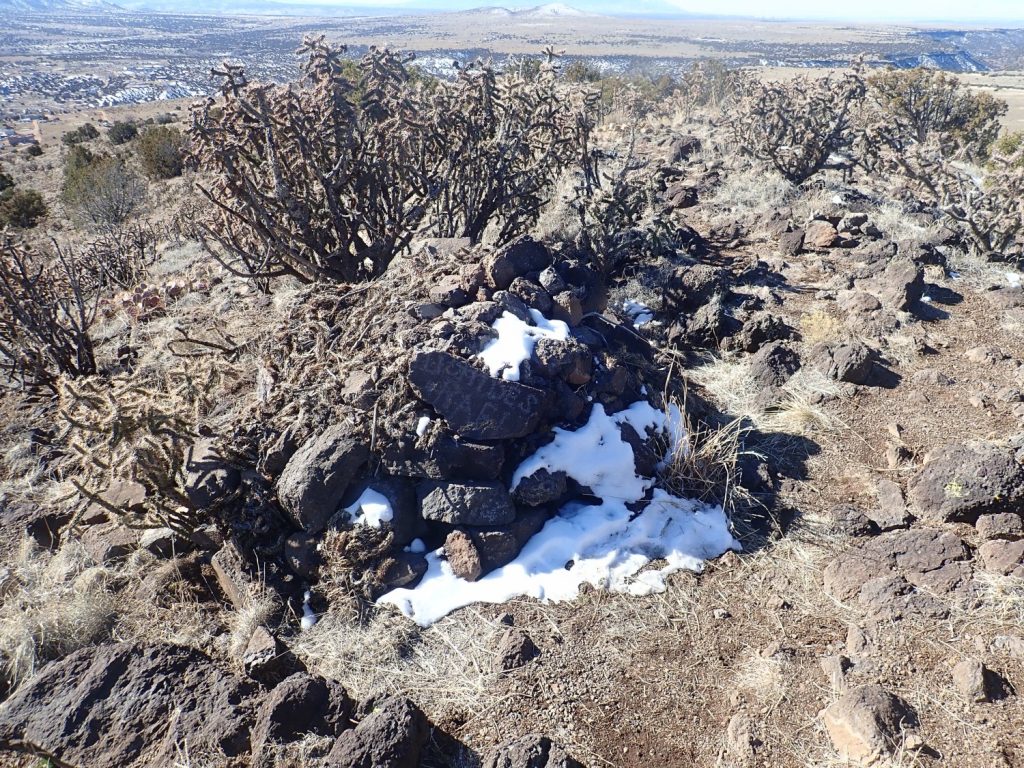
But I do not know the significance of all the cholla branches.
I got back to Matheson Gas, picked up my filled cylinders, got home, put together the new regulator … and found the solenoid would not open. Puttered with it. Unscrewed the solenoid assembly to see if something was stuck: no. The solenoid was just not powerful enough to reliably grab the valve and open it. Crappy design. The intent was to reduce heating and power usage by making the solenoid just strong enough to do the job, but somebody got his sums wrong.
I should have known. This is literally a Chinese copy of an American design costing twice as much. I should have paid twice as much. Wrapped it up, contacted Amazon, got the labels to return it for refund. I’ll order the twice-as-expensive American version as my birthday present next month, and hope it works better. It has good reviews from sources I trust.
(But then the Chinese version had good reviews at a number of sites online. I guess I don’t trust those sites now.)
Got the results of the MRI that afternoon. I’m not a doctor … well, actually, I am, just not a physician. But I have some education and access to Google. There were three findings. Two are probable incidental: a developmental venous anomaly (“quirky veins that have probably been there doing me no harm since I was a baby”) and a small arachnoid cyst (“collection of fluid in one of membranes around the brain, also probably there and doing me no harm since I was a baby”.) The more significant finding was diffuse parenchymal enhancement; it was reassuring that the radiologist said it really didn’t look like cancer (though unsettling that the subject even came up) and was probably due to intracranial hypotension. I looked up intracranial hypotension, then one of its causes, cerebrospinal fluid leak, and bingo. The symptoms closely match what I’ve been experiencing for the last two months. I’m leaking CSF fluid somewhere.
Getting just a bit ahead of my story: My P.A. discussed all this with me in a followup appointment later that week, and referred me to a neurologist. Who could not see me before 2 April. Well, if they’re not rushing me in, I must not be dying? Anyway, if the tentative diagnosis of CSF leak is correct, it’s a condition that hardly ever kills anyone, only occasionally disables anyone, and can very often be completely cured. Sometimes it even resolves on its own. Y’all pray for me to be that lucky, please.
The sources said that drinking lots of fluids helps. I began forcing fluids, and it does help, a lot. I wonder if that helps confirm the diagnosis. My neck has stopped hurting and the headaches are really quite mild. But not completely gone away.
So why am I leaking CSF? Four theories. I cracked my head on the bottom of the stairs early in December, though I didn’t think much of it at the time. I threw my lower back out in mid-December, though I don’t think the dura reaches that far south. I have arthritis in my middle spine, which is apparently where most CSF leaks occur. Or it could be a spontaneous CSF leak. We’ll see what the neurologist says, assuming CSF leak is the correct diagnosis to begin with; that’s still quite tentative.
Anyway, back to Washington’s Birthday weekend: I invited my friend, Alden Stradling, and his family on another hike on Washington’s Birthday itself. We seriously considered Kashe-Katuwe, but the time was just too tight; I ended up taking them to Cerro Seguro. I didn’t mind a second visit and I knew the trail would be good.
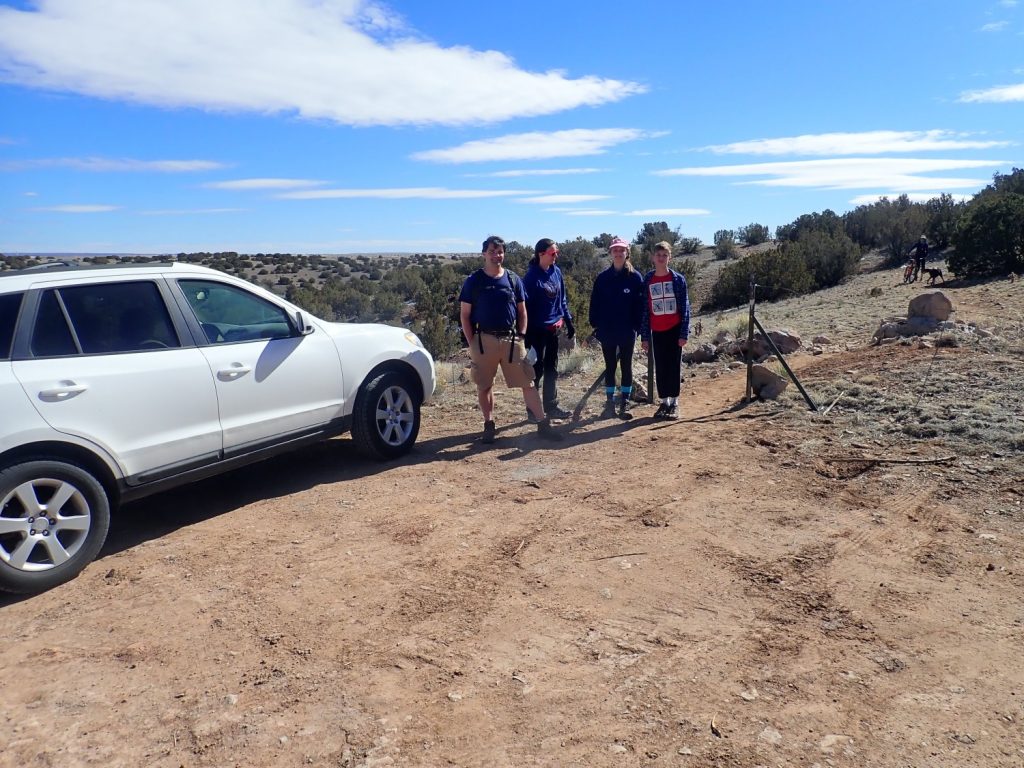
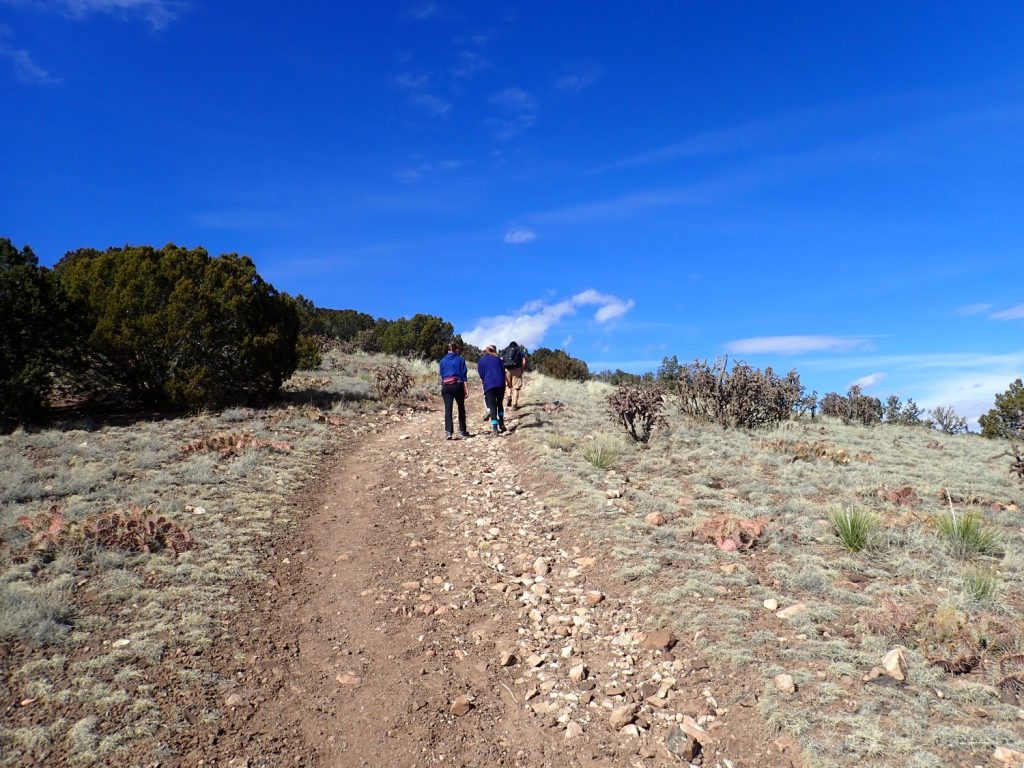
Didn’t take a lot of pictures. I already had plenty and the conversation was just way too much fun.
The next day, I learned that my friend Gary Stradling, Alden’s father, who could not quite fit the hike into his schedule, had had a heart episode. I call it that because he did not actually lose any heart muscle. But he had a bad attack of chest pain and they ended up putting two stents into two coronary arteries that had gotten alarmingly narrowed. Gary’s comment afterwards was “Good as new.” I admire that kind of cheerful optimism. Anyway, if the stents settle in okay, the blood supply to his heart really should be ample and he really will be fit for further adventures. He was pretty lucky.
Other odds and ends: I got looking at some Java moss from my aquarium, and it’s loaded with stentor. Movie: http://kgbudge.com/videos/stentor_hava.mov
Last Saturday I found time to visit Gary, who was recuperating, and we amused ourselves watching Them! This is the very best of the “creature features” of the 1950s.
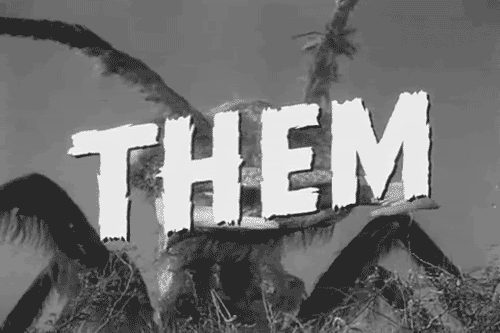
If you’re thinking “That’s not saying much”, no: The budget was adequate, the acting was good (you’d be surprised how many names you’d recognize), and the plot was about as intelligent as one could hope. Sure, these kinds of movies will have some plot holes, but that doesn’t seem to have bothered fans of Star Wars or Star Trek.
Yesterday I had the root canal. It seemed to go fairly well. The endodontist rapped on my teeth, and, yeah, #19 didn’t care much for that. Oddly, it was completely insensitive to cold. Turns out it’s because the nerve was completely dead. When he drilled out the heart of the tooth, he found no bleeding in any of the three root canals, showing that everything had already died. Then he scrubbed out the canals, disinfected everything (apparently with bleach), filled the canals with rubber, put in a post to provide mechanical support, filled the tooth interior, and put a temporary uppermost filling my dentist is supposed to replace with something more permanent at my convenience. The hardest parts for me were when the novocaine went in and having to hold my mouth wide open for an hour.
The novocaine was something. I was most thoroughly numbed, Jar Jar Binks-level. It took most of the day to wear off. Plus side: I didn’t feel a thing once it took hold. Minus side: Could not safely eat unti late afternoon. The tooth is a bit sensitive, which is a bit surprising considering all its nerves were just scrubbed out with Chlorox. Ghost pain, I think.
So that’s more or less the update for today. I felt entitled to take it easy today on account of the root canal. I may be visiting the Small Fry Prospect with Gary Stradling tomorow, but only if he has the wholehearted blessing of cardiologist and spouse. Otherwise, still waiting for proper hiking weather.

“ The sources said that drinking lots of fluids helps. I began forcing fluids, and it does help, a lot. I wonder if that helps confirm the diagnosis. My neck has stopped hurting and the headaches are really quite mild. But not completely gone away.”
You are slacker wrt drinking water, because your thirst reflex is hindered by diabetes.
I am well rebuked.